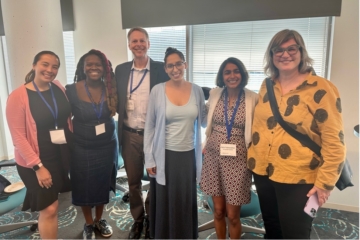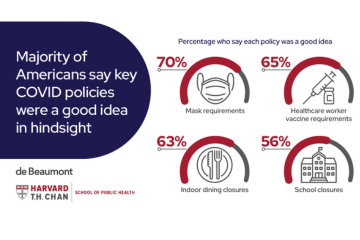
On the importance of language:
“The bottom line is, we have to work together and use the right language to promote vaccine confidence. If we’re not confident in this vaccine, and people don’t take it, then we’re not going to get through this pandemic. The fastest way to get back to normal, to get our economy moving, and for people to protect themselves and their families, is to take the vaccine. And that really needs to be the number-one priority right now.”
On vaccine acceptance and uptake:
“There are many people who will take this vaccine. But you know the saying, ‘a chain is only as strong as its weakest link’? We’re only going to be as protected as the group that uptakes the vaccine the least. And so it’s important to understand the differences in vaccine acceptance so we can help those who may be skeptical or concerned about the vaccine to take it.”
On speaking to rural communities:
“Rural and farm communities really have much less confidence in the safety of the vaccine, so we have to be clear that the FDA was involved at every step along the way of vaccine development. No corners were cut. This is a safe vaccine. And when you hear about things like side effects, they’re just your body’s natural responses to a vaccine. And they’re occurring very rarely. Even the most severe side effects are easily handled in a hospital setting. And for rural communities, and also younger Republicans, a return to normal is something that is a high priority, and then opening the economy. So messages about personal health and safety are a little less impactful. You need to work in the issues around returning to normal and opening the economy.”
On trust within families:
“People trust their family members more than they trust government institutions, so as public health leaders, we need to find those in the community who want to champion vaccine uptake. We need to prepare them, we need to give them the right words and messaging, so that they can talk to people and be advocates.”
On “selling” the vaccine:
“We go into things like public health to serve our community, and we don’t think we have to be salespeople. But we are selling a vaccine in a lot of ways to the community. And what we have to be sure of is that we understand where they’re coming from. Get into their brain — what’s in it for them? And for many people, it’s that return to normalcy. It’s the fact that you can go back to Thanksgiving next year, you can see your family and friends, you can go to that concert you’ve been waiting for, we can have a college football season.
“These are the things that will help motivate people to take the vaccine, and what we get back as a society if we achieve herd immunity. So what are those things that will really help people see that there are these benefits to taking this vaccine? It may be different for different people, but ultimately, it’s not about finger-wagging at people and saying, ‘If you don’t take this vaccine, X number of more people are going to die.’ Let’s take a positive turn on this. ‘If you choose to take the vaccine, we can get back to normal, we can have that prom that might be coming up in May, you might get to go to your kid’s graduation. But if we don’t take it, those things might not be as accessible.'”
Tips for talking about vaccination:
#1: Personalize messages.
“There isn’t a one-size-fits-all message here. We’re going to have to tailor what we’re saying to our different audiences. You have to personalize the messages; we’re taking the vaccine to protect our family and friends. That’s why, not because it’s a national duty, or it’s just the right thing to do. The right thing to do is a value judgment. But protecting your family is very consistent to everyone.”
#2: Use positive language over negative language.
“Positive language works so much better than negative language. So kind of do it like an Oreo cookie, where the cookie is the positive language, and you can use that white stuff in the middle as the consequence. But start with positive: We’re getting back to our normal lives and our economy, and then go with, if we don’t take this, more people could perish, and then end with another positive: If you take the vaccine, you’re going to protect your friends and [family].”
#3: Talk about the benefits.
“It’s 100% staying healthy. That’s what people need to hear. And that’s what will encourage them to get the vaccine. So that positive language: Stay focused on the benefits of taking the vaccine. And if you take the vaccine, we’ll get to where you want to go, which is back to normal. We all don’t want to lose another summer or another Thanksgiving. And so using the positive messages will help people with vaccine uptake.”
#4: Be non-judgmental.
“Most importantly, there really can’t be judgment. And when we started out the conversation around [the COVID-19] vaccine, with identifying people who were vaccine hesitant, we kind of already started out with a negative. You’re gonna get much more uptake when you say to folks, ‘I understand that you may have concerns, and what questions can I answer for you about the vaccine?’
“It’s about being concerned or skeptical, which kind of suggests an inquisitiveness or caution, where hesitancy kind of signals opposition. And I think that’s one of the ways that we can again, change our language to bring more people to this vaccine, and help them make a decision that’s right for them, which we hope is to take the vaccine.”
Listen to other episodes of “Healthy You: Surviving a Pandemic.”




